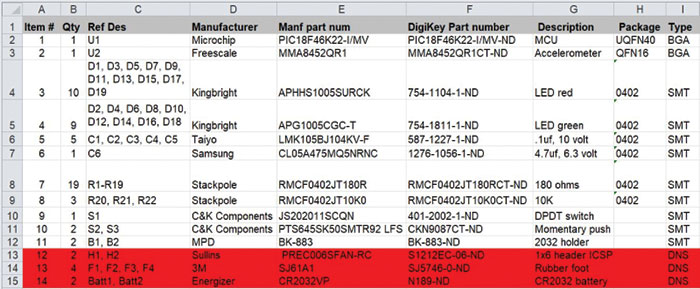The Ideal Bill of Materials
 A user’s guide to clear communication of parts and intent.
A user’s guide to clear communication of parts and intent.
A good portion of a quality build is simply the result of clear information. One of the more important pieces of information we deal with is the bill of materials, called “the BoM.”
The BoM is a list of all the components to be placed on the PCB. The file typically includes an index number, the number of times a specific component will be used on the board, the reference designator from the schematic, the component manufacturer, and the manufacturer’s part number.
If a specific component is used more than once – a common bypass capacitor, for example – it will still only take up one line in the BoM. One field in the BoM will list the number of times the component is used, and another field will list all the reference designators for that part number. In FIGURE 1, for example, line 5 in my BoM is a 0.1 microfarad, 10V capacitor.

Figure 1. Sample bill of materials.
The first field in the table has a line item index, 5, because this is the fifth unique part number in my BoM. The next field has the quantity of this component used on the board, which is 5. Field three holds reference designators C1, C2, C3, C4 and C5. The next field has the manufacturer, and the final field has the manufacturer’s part number.
You will likely have additional fields, such as a distributor part number, a description, the package type and other tidbits, as I have here. But the first five columns in this example show what is generally considered to be the minimum data set for a good bill of materials.
Note the three lines at the bottom highlighted in red with the label “DNS” in the Type column.
DNS means “do not stuff.” That’s an instruction to the manufacturer to not install that component during the assembly phase. Some people use DNP, for do not place, or DNI, for do not insert. It’s always best to consult with your manufacturer for their preferred labeling.
You may also want to include alternate parts for components likely to go out of stock. Passives, such as capacitors and resistors, are notorious for going out of stock without notice. Invariably, though, a half dozen nearly identical parts will fit the bill just as well.
Create an alternates list so the purchasing folks or manufacturer won’t get stuck not knowing if a substitute is valid or not.
is marketing manager and chief technology champion at Screaming Circuits (screamingcircuits.com); This email address is being protected from spambots. You need JavaScript enabled to view it..




